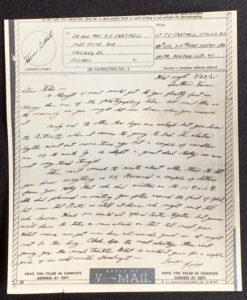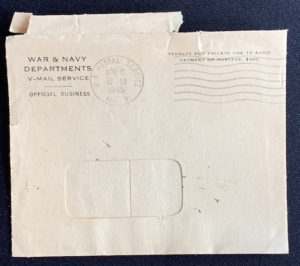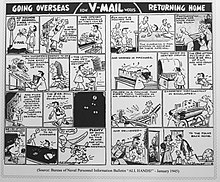
Victory Mail, or V-Mail was a system of photographic transmission of letters to and from overseas stations during World War II.
After writing a letter on V-Mail paper, the letter was passed by the censors, and then photographed. The photograph was transferred to microfilm, and the microfilm reel flown to a processing plant in the continental U.S.
Each microfilm image was printed onto photographic paper, folded, and placed in a windowed envelope, which would then be delivered through the usual postal service.
Some of Tom’s letters were written on regular stationary, and others in V-Mail format. It’s uncertain how or why he decided which to choose.

From Wikipedia:
V-mail, short for Victory Mail, was a hybrid mail process used by the United States during the Second World War as the primary and secure method to correspond with soldiers stationed abroad. To reduce the cost of transferring an original letter through the military postal system, a V-mail letter would be censored, copied to film, and printed back to paper upon arrival at its destination. The V-mail process is based on the earlier British Airgraph process.[1][2]
Operation and function
V-mail correspondence was on small letter sheets, 17.8 by 23.2 cm (7 by 9 1⁄8 in), that would go through mail censors before being photographed and transported as thumbnail-sized image in negative microfilm. Upon arrival to their destination, the negatives would be printed. The final print was 60% of the original document’s size, creating a sheet 10.7 by 13.2 cm (4 1⁄4 by 5 1⁄4 in).

Explanation of V-Mail System in Display aboard USS Alabama (BB 60), Mobile, Alabama
According to the National Postal Museum, “V-mail ensured that thousands of tons of shipping space could be reserved for war materials. The 37 mail bags required to carry 150,000 one-page letters could be replaced by a single mail sack. The weight of that same amount of mail was reduced dramatically from 2,575 pounds to a mere 45.” This saved considerable weight and bulk in a time in which both were hard to manage in a combat zone.
In addition to postal censorship, V-mail also deterred espionage communications by foiling the use of invisible ink, microdots, and microprinting, none of which would be reproduced in a photocopy.
